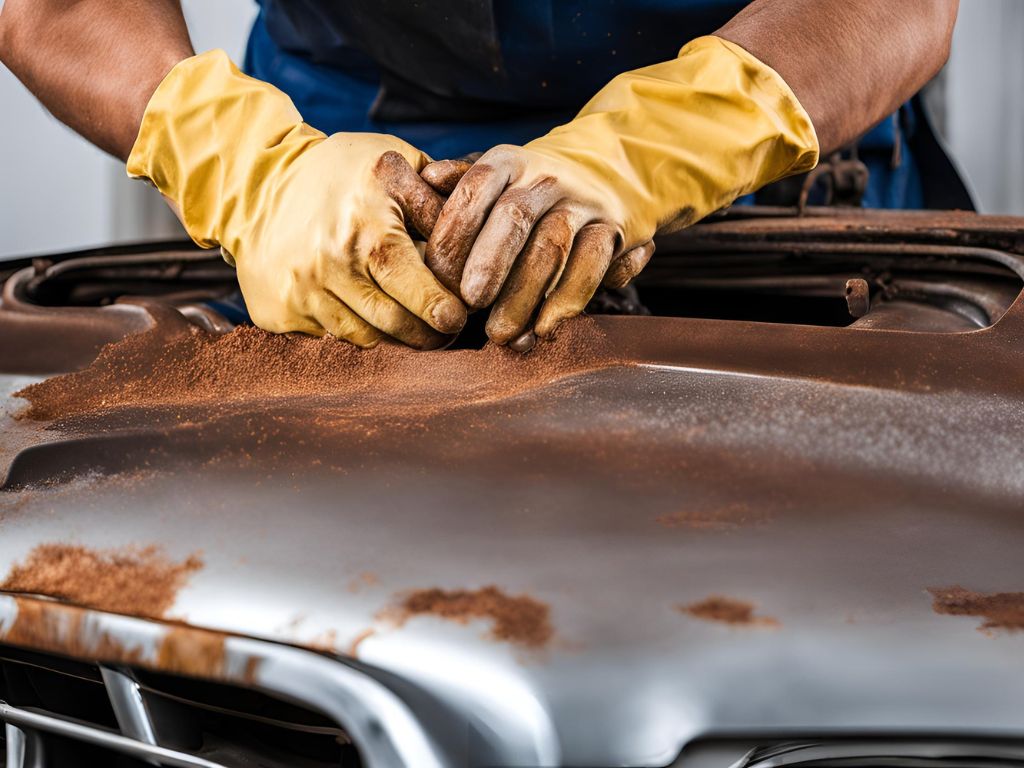When it comes to preserving the longevity and performance of our beloved cars, battling one of the most common enemies, rust, is often a challenge. But it's not always necessary to resort to extreme methods such as sanding, grinding, or welding. There are several other effective methods for removing rust from metal parts in cars that are more accessible and can be carried out without hiring a professional mechanic. This article intends to explore those methods, offering step-by-step guides on how to tackle rust, even with minimal to no auto repair experience. Welcome to your must-read guide to keeping your vehicle squeaky clean and rust-free, without resorting to daunting mechanical procedures.
Chemical Rust Removers
When it comes to removing rust from car parts without resorting to excessive physical grinding or welding, chemical rust removers offer a highly effective solution. Let's delve into choosing the right chemical rust remover and how to apply it efficiently.
Choosing the Right Chemical Rust Remover
Recognizing the perfect chemical rust remover suitable for your task can make all the difference. While there are numerous chemical rust removers on the market, the best ones will effectively dissolve and remove rust without causing damage to the metal part.
Advantages of Using Chemical Rust Removers
Chemical rust removers bring about several benefits. When applied right, they are incredibly potent and can detectorate rust in mere minutes or hours. Unlike sanding or grinding, chemical rust removers don't have the downside of potentially damaging the metal piece by thinner or altering its shape. Instead, they target only the rust, leaving the integrity of the metal part intact.
Safety Precautions
Although chemical rust removers are effective, it's crucial to remember that they can be harmful if not handled correctly. Ensure to use gloves and protective eyewear when applying the remover. Work in a well-ventilated area to avoid inhaling the harsh chemicals. Lastly, ensure to store these chemicals out of the reach of children and pets.
Application Process
Understanding the correct application process can maximize the efficiency of your rust removal.
Preparation of Metal Parts
Before the application, you must prepare the metal parts. Remove loose rust or dust from the metal surface using a wire brush. The cleaner and dust-free you get the metal, the more effectively the chemical rust remover can work.
Steps to Apply Chemical Rust Removers
Once you've prepared the metal part, follow these steps to apply the chemical rust remover:
- Apply the chemical rust remover liberally to the rusted areas.
- Allow the remover to sit for the specified time on the product's instructions.
- Once the time has elapsed, use a soft brush or cloth to wipe away the chemical and the dissolved rust.
- Rinse the part thoroughly with water. If any rust remains, repeat the process.
Always remember to dispose of any used chemicals and rags responsibly following local guidelines.
In conclusion, chemical rust removers offer a potent, non-invasive method of treating rust on your car's metal parts. With the right safety measures and application process, you can restore your metal components effectively and efficiently.
Electrolysis Rust Removal
Electrolysis is another highly effective method for removing rust from metal parts in cars without the need for sanding, grinding, or welding. This process uses the power of electricity to reverse the oxidization process, thus removing rust and restoring the metal to its original state.
Understanding Electrolysis
Principles of Electrolysis in Rust Removal
Broadly put, the principles of electrolysis in rust removal involve forcing an electric current through a solution or electrolyte. This causes the iron oxide (rust) on the metal part to be converted back into iron. In essence, this process decays the rust off the metal part, leaving it clean and rust-free. It is an ingenious method that has been proven to work over and over again.
Important Note: Although electrolysis is a highly effective rust removal method, it requires a good understanding of the process to be done correctly. It is vital to follow safety instructions, as dealing with electricity always poses certain risks.
Required Equipment and Setup
For effective electrolysis rust removal, you will need specific equipment. These include:
- A plastic or glass container large enough to fully submerge the rusty metal parts
- A power supply (like a car battery charger)
- A sacrificial anode – this can be any piece of metal, but steel and iron are commonly used
- Baking soda or washing soda to prepare the electrolyte
- Water.
While setting up, ensure the positive terminal of the power supply is connected to the anode, while the negative terminal connects to the rusty item.
Step-by-Step Electrolysis Process
Having understood the principle and acquired the necessary equipment, the next step is to go through the electrolysis process.
Setting Up the Electrolysis Bath
To set up the electrolysis bath:
- Fill your container with enough water to cover the metal part entirely.
- Dissolve soda in the water. A ratio of one tablespoon of soda for every gallon of water is often sufficient.
- Connect the rusty metal part to the negative terminal of your power supply using an insulated wire, then submerge the part in the bath.
- Connect the sacrificial anode to the positive terminal and submerge it in the water, making sure the anode and your rusty part don’t touch.
Monitoring and Completion
Once the setup is complete and your power supply is turned on, bubbles will start to appear, which is the electrolysis process taking place. Regular monitoring is crucial, but the process isn't fast, often taking several hours or even up to a day, depending on the size and level of rust.
Final completion is confirmed when bubbling ceases, signaling that there is no more rust on the metal. Carefully remove the now rust-free piece, dry it out, and treat it to prevent future rusting.
In summary, electrolysis rust removal is a reliable, damage-free method to tackle the rust problem without resorting to sanding, grinding, or welding. Just remember to follow safety procedures to prevent any electrical accidents. As a bonus, this method is also environmentally friendly, as it uses only water and baking soda, which are completely safe and non-toxic.
Using Rust Converters
When it comes to removing rust from metal parts in cars, one versatile and straightforward solution is the use of rust converters. Rather than hassling with sanding, grinding, or welding, this option allows you to tackle the rust issue chemically. To effectively use this method, it's essential to understand how rust converters work and how to safely apply them to your vehicle.
How Rust Converters Work
Chemical Composition and Reaction
At their core, rust converters are complex chemical solutions typically composed of tannic acid and an organic polymer. The primary function of rust converters is to interact with iron oxide – commonly known as rust – and convert it into a more stable material that can be easily painted over.
When a rust converter is applied to a rusty metal surface, it undergoes a chemical reaction. The rust converter's tannic acid reacts directly with the rust to form iron tannate, a black and stable material. Simultaneously, the organic polymer creates a protective layer that seals the newly formed iron tannate from further exposure to moisture and oxygen – the two elements responsible for rust formation.
Benefits of Rust Converters
Rust converters offer various benefits when it comes to treating rusted metal parts. First and foremost, they eliminate the need for intense laborious practices like sanding or grinding. While these methods can help remove rust, they can also result in the removal of healthy metal parts.
A key advantage of using rust converters is the ability to target and convert rust while preserving the integrity of the metal part. This makes it an excellent choice for treating delicate or intricate car components, where physical abrasion could cause more harm than good.
Application Techniques
Preparing the Surface
Prior to applying a rust converter, you need to prepare the surface of the metal part. Start by removing any loose rust or scaled metal using a wire brush. The goal isn't to remove all the rust – that's the job of the rust converter – but rather to clear away any flaking or unstable rust that could interfere with the converter's performance. Keep in mind that rust converter won't be effective on painted surfaces, so make sure to expose the rusted areas.
Applying Rust Converter to Metal Parts
Once prepared, the application process for rust converter is straightforward. It can be brushed, rolled, or sprayed onto the rusted surfaces depending on the area's size and accessibility. After the initial application, allow it to cure for the time specified on the product instructions. Generally, it takes about 20 minutes to 24 hours.
Remember, after the rust converter has fully dried, it's always recommended to apply a primer and paint over the now converted surface. This will provide an additional layer of protection against future rust formation.
While rust converters can be a game-changer for maintaining old cars, always remember to follow precautionary steps outlined in the product’s manual to ensure safety and effectiveness.
Natural Rust Removal Methods
Let's dive into some of nature's most effective, non-toxic solutions for rust removal: vinegar and baking soda, as well as lemon juice and salt. These are simple, cost-effective, and accessible options for removing rust from metal parts in cars without resorting to sanding, grinding, or welding.
Using Vinegar and Baking Soda
Vinegar and baking soda have gained substantial recognition in the world of rust removal. Let's take a closer look at why this method is favored and how it can be done at home.
Benefits of Natural Methods
One significant advantage of natural rust removal methods is their eco-friendliness. Being free of harmful chemicals, they pose no threat to the environment or the user's health. Besides, ingredients like vinegar and baking soda are easily accessible, making this an affordable alternative.
Steps for Using Vinegar
The vinegar method is a straightforward and effective way to get rid of rust on car parts. Here's how you can do it:
- Submerge the rusted car part in white vinegar and let it sit for 24-48 hours.
- After the soak, use a brush or cloth to rub the rust off gently. The vinegar helps to loosen the rust, making it easier to remove.
- Rinse thoroughly with water and let it dry.
Lemon Juice and Salt Application
If you are looking for another natural method to remove rust without having to resort to abrasive tools, consider using a mixture of lemon juice and salt.
Combining Lemon Juice and Salt
The mixture of lemon and salt is another potent solution that works effectively to remove rust from metal surfaces. The acid from the lemon juice loosens the rust while the salt’s abrasive nature helps to scrub it off without causing any damage to the metal surface.
Advantages of This Method
Much like the vinegar and baking soda method, using lemon juice and salt doesn't involve any hazardous chemicals. It's economical, easily accessible, and less labor-intensive than conventional rust removal methods.
Make sure to rinse thoroughly and dry after applying this method, as salt can cause further corrosion if left unattended.
Natural rust removal methods offer both financial and environmental benefits that make them excellent choices, especially for small-scale rust issues. While they may require more time, the end results are highly rewarding.
Preventing Future Rust on Car Metal Parts
Rust can significantly decrease the lifespan and value of your car. However, several steps can effectively preserve the integrity of the metal parts. These steps include applying protective coatings and employing regular maintenance practices for rust prevention. 🚗
Applying Protective Coatings
When discussing rust prevention, applying protective coatings is a go-to method. There are several types of anti-rust coatings available, each with their unique application processes and advantages.
Types of Anti-Rust Coatings
Choosing the right anti-rust coating depends heavily on the nature of the metal part it's intended for. Some common types of anti-rust coatings include:
- Oil-Based Coatings: These tend to be inexpensive and easy to apply. Perfect for protecting parts that aren't exposed to high levels of heat or stress.
- Epoxy Coatings: These provide a higher level of protection against rust and are used in areas exposed to harsh conditions. Despite their superior performance, they require a more complex application process.
- Zinc Coatings: These works by preventing oxygen and water from reaching the metal surface, hence preventing rust formation. Another advantage is that even if the coating gets scratched, the underlying metal remains protected.
Step-by-Step Coating Application
To maximize the effectiveness of an anti-rust coating, follow these basic steps:
- Clean the Surface: Start by cleaning the surface of the metal to remove dust, oil, or previous paint.
- Remove Existing Rust: If your metal parts already have rust, remove it using a rust converter or mechanical method.
- Apply the Primer: Use a rust-inhibiting primer to create an adhesive surface for the coating.
- Apply the Coating: Use a brush, roller, or spray gun to apply the anti-rust coating evenly on the surface.
- Let it Dry: Allow the coating to dry properly before exposing the part to water or operating the vehicle.
Following these steps can help significantly extend the lifespan of your car's metal parts and keep them rust-free. 🖌️👍
Regular Maintenance Tips
Equally important as applying a good protective coating is conducting regular maintenance of your car's metal parts. Prevention is always better than cure.
Routine Inspection and Cleaning
It is crucial to inspect your car regularly for rust, especially in hidden, hard-to-reach areas. Treat any rust spots you find as soon as possible to prevent spreading.
Also, clean your car regularly, paying particular attention to the underbody and wheel wells which are prone to trapping water and salts. This will not only keep your car looking great but also help keep rust at bay.
Long-term Rust Prevention Strategies
For an effective long-term rust prevention strategy, consider these tips:
• Garage Your Car: Whenever possible, keep your car in a covered, dry area to protect it from rain, snow, and moisture which can cause rust. • Rustproof Annually: Make rustproofing a yearly maintenance task, especially if you live in a high-rust area. • Wax Your Car: Waxing your car not only makes it shiny but also provides a barrier against rust.
Remember, the fight against car rust is a continual one. But with the correct preventative measures, you can keep your car rust-free for a long time. 🚗💪
The next time someone asks, "What are some effective methods for preventing future rust on car metal parts?", you'll know exactly what to recommend!






